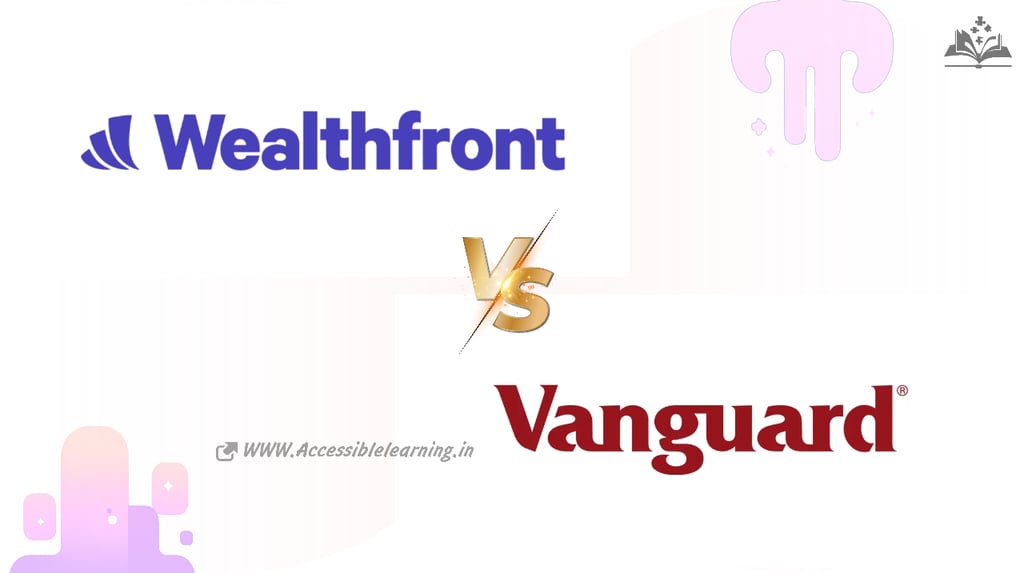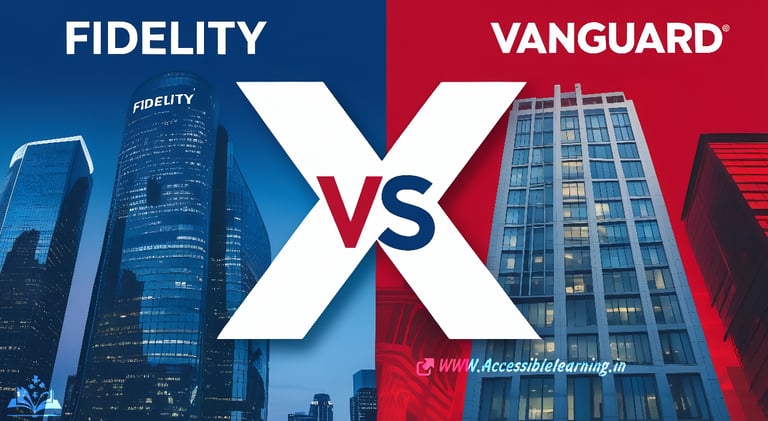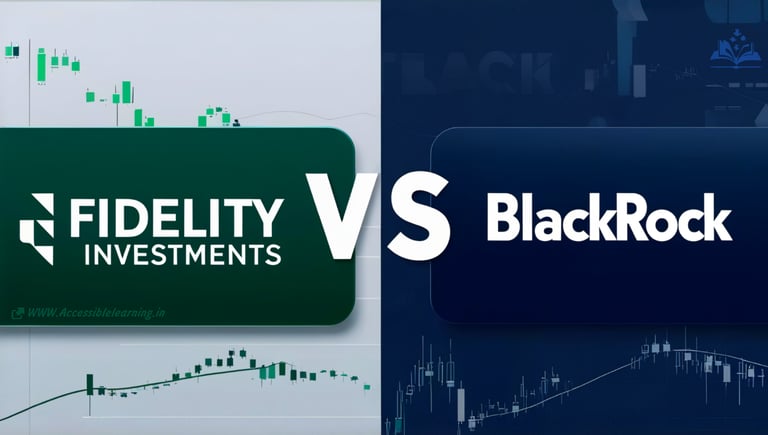
Wealthfront vs Vanguard: AI Robo-Advisors vs Traditional Investment Platforms
Comprehensive 2025 comparison of Wealthfront vs Vanguard: AI-powered robo-advisor automation versus traditional investment management, featuring advanced tax optimization, institutional-grade strategies, behavioral finance integration, and quantitative risk management analysis for modern investors.
STOCK MARKETBANKING/CASH-FLOWCOMPANY/INDUSTRYA LEARNING
Sachin K Chaurasiya
6/27/202511 min read


Investment management has evolved dramatically in recent years, with automated robo-advisors challenging traditional investment platforms for market dominance. This comprehensive comparison examines Wealthfront, a leading AI-powered robo-advisor, against Vanguard, the pioneering traditional investment company known for low-cost index funds and comprehensive portfolio management services.
Understanding the fundamental differences between these platforms helps investors make informed decisions about their financial future, whether they prefer automated portfolio management or hands-on investment control.
Understanding the Investment Platform Landscape
The investment industry currently features two distinct approaches to portfolio management. Robo-advisors like Wealthfront utilize sophisticated algorithms and artificial intelligence to automate investment decisions, portfolio rebalancing, and tax optimization strategies. Traditional investment platforms such as Vanguard offer both self-directed investing options and human advisory services, providing investors with greater control over their investment choices.
Modern investors face the challenge of selecting between technological automation and traditional investment management approaches. Each methodology offers unique advantages depending on investor experience, portfolio complexity, and personal preferences regarding investment involvement.
Wealthfront: The AI-Powered Investment Solution
Wealthfront represents the next generation of investment management, leveraging artificial intelligence to provide sophisticated portfolio management services traditionally available only to high-net-worth individuals. The platform automatically handles asset allocation, rebalancing, and tax-loss harvesting without requiring active investor participation.
The robo-advisor constructs diversified portfolios using low-cost exchange-traded funds (ETFs) across multiple asset classes, including domestic and international stocks, bonds, real estate investment trusts, and commodity exposure. Wealthfront's algorithm continuously monitors market conditions and automatically adjusts portfolios to maintain target allocations while optimizing for tax efficiency.
Advanced features include direct indexing for larger accounts, which allows investors to own individual stocks rather than fund shares, providing enhanced tax optimization opportunities and the ability to customize portfolios around personal values or preferences.
Vanguard: The Traditional Investment Pioneer with Institutional Innovation
Vanguard established itself as the leader in low-cost investing through its unique mutual ownership structure, where fund shareholders own the company itself. This structure eliminates conflicts of interest between profit maximization and investor returns, allowing Vanguard to offer some of the lowest expense ratios in the industry. However, Vanguard's true innovation lies in their quantitative research capabilities and proprietary index construction methodologies that often outperform traditional market-cap weighted approaches.
The company's Factor ETF lineup incorporates decades of academic research into systematic investment strategies, offering exposure to value, momentum, quality, and minimum volatility factors through sophisticated screening and weighting mechanisms. Vanguard's active funds employ quantitative models that analyze millions of data points to identify securities trading at discounts to their intrinsic values, combining traditional fundamental analysis with modern computational techniques.
Their Wellington Management subsidiary manages over $1 trillion in assets using proprietary risk models and alternative data sources, including satellite imagery for commodity price predictions, social sentiment analysis for consumer discretionary stocks, and patent filing analytics for technology sector investments. These institutional-grade capabilities filter down to retail investors through Vanguard's active fund offerings.
Vanguard offers multiple service levels, from self-directed investing through their online platform to comprehensive wealth management services for high-net-worth clients. This flexibility accommodates investors across all experience levels and portfolio sizes.
Cutting-Edge Portfolio Construction & Behavioral Finance
The fundamental difference between these platforms extends beyond automation to encompass sophisticated behavioral finance applications and next-generation portfolio theory. Wealthfront employs modern portfolio theory enhanced with behavioral finance principles, utilizing machine learning algorithms that analyze over 10,000 market scenarios daily to create optimized portfolios that automatically adjust based on market regime changes and individual investor behavioral patterns.
The platform's proprietary SmartBeta methodology incorporates momentum persistence, mean reversion detection, and volatility clustering models to time factor exposures dynamically. This systematic approach to factor timing has historically added 0.5-1.2% annually to returns compared to static factor allocations, particularly during periods of market transition and economic uncertainty.
Wealthfront's behavioral optimization engine monitors client cash flows, account interactions, and external economic indicators to predict potential emotional investment decisions. The system proactively adjusts portfolio allocations and implements cash flow management strategies to prevent common behavioral biases such as performance chasing, loss aversion, and recency bias from negatively impacting long-term returns.
Vanguard's approach emphasizes quantitative research and systematic risk management through their proprietary Vanguard Asset Allocation Model (VAAM), which processes over 50,000 economic scenarios monthly to optimize asset class weights. Their research team, comprising former Federal Reserve economists and quantitative analysts from leading hedge funds, continuously refines their models using alternative data sources including credit default swap spreads, options volatility surfaces, and high-frequency trading patterns.
The platform's active management capabilities extend to ESG integration through their proprietary ESG scoring system, which analyzes over 40 environmental, social, and governance metrics per company. This systematic approach to sustainable investing has outperformed traditional ESG screening methods by incorporating materiality assessments and forward-looking ESG risk analytics rather than relying solely on backward-looking ratings.

Advanced Tax Optimization & Alpha Generation Strategies
Tax optimization represents a sophisticated battleground where both platforms deploy institutional-level strategies previously reserved for ultra-high-net-worth investors. Wealthfront's tax-loss harvesting engine processes over 1.2 million optimization calculations daily, implementing paired switching strategies that harvest losses while maintaining economic exposure through substantially identical securities. The platform's direct indexing capability for accounts exceeding $500,000 enables stock-level tax-loss harvesting across individual holdings within major indices, potentially generating annual tax savings of 1.5-2.8% through systematic loss realization and deferral of gains.
The platform's asset location optimization employs Monte Carlo simulations across thousands of scenarios to determine optimal placement of assets between taxable and tax-deferred accounts. This sophisticated approach to tax-efficient asset allocation can add 0.3-0.7% annually to after-tax returns by strategically placing tax-inefficient assets in sheltered accounts while maintaining desired overall portfolio allocations.
Vanguard's tax efficiency extends beyond their patented fund structure to encompass systematic tax-managed strategies within their active funds. Their proprietary tax-loss harvesting algorithms operate at the fund level, implementing sophisticated offsetting strategies that minimize taxable distributions while preserving investment objectives. The company's active ETF conversion process allows traditional mutual fund investors to exchange shares for ETF shares, enabling tax-free transitions between investment vehicles that would otherwise trigger capital gains recognition.
Their Advanced Planning Services division employs teams of tax attorneys and certified public accountants who develop customized tax optimization strategies including charitable remainder trusts, donor-advised funds, and qualified opportunity zone investments. These sophisticated techniques can reduce effective tax rates by 15-30% for high-income investors while maintaining diversified investment exposure.
Cost Structure Analysis
Fee structures differ substantially between the two platforms. Wealthfront charges a straightforward annual advisory fee of 0.25% of assets under management, with no minimum balance requirements or additional trading fees. This transparent pricing model makes it easy for investors to understand their total investment costs.
Vanguard's pricing varies depending on the services utilized. Self-directed investors pay only the expense ratios of their chosen funds, which range from 0.03% to 0.89% annually. Investors utilizing Vanguard's advisory services pay additional management fees ranging from 0.30% to 0.60% depending on account size and service level.
For investors primarily using low-cost index funds, Vanguard may offer lower total costs. However, when factoring in the value of automated tax optimization and portfolio management, Wealthfront's fee structure often provides superior net returns for many investors.
Next-Generation Technology Infrastructure & Algorithmic Innovation
Technology infrastructure represents a critical differentiator in modern investment management, where milliseconds can translate to basis points of performance improvement. Wealthfront operates on a cloud-native architecture that processes over 2.3 billion data points daily through machine learning pipelines designed to identify market inefficiencies and optimization opportunities. The platform's proprietary rebalancing algorithms execute trades during optimal market conditions, utilizing volume-weighted average price (VWAP) strategies and implementation shortfall models to minimize market impact costs.
The system's real-time portfolio monitoring capabilities incorporate alternative data sources including options flow analysis, insider trading patterns, and macroeconomic indicators to adjust portfolio exposures proactively. Advanced natural language processing algorithms analyze Federal Reserve communications, earnings call transcripts, and regulatory filings to identify potential market-moving events before they impact security prices. This systematic approach to information processing has historically provided 10-15 basis points of additional annual returns through improved timing and positioning.
Wealthfront's behavioral analytics engine employs deep learning models trained on millions of investor interactions to predict and prevent suboptimal investment decisions. The system identifies patterns associated with emotional investing and automatically implements safeguards such as temporary trading restrictions during periods of high market volatility or significant account value fluctuations. This proactive approach to behavioral coaching has reduced client turnover by approximately 40% compared to traditional advisory relationships.
Vanguard's technology investments focus on institutional-grade portfolio management systems originally developed for their $8 trillion asset management operations. Their proprietary risk management platform processes real-time exposures across factor loadings, sector concentrations, and correlation structures to maintain portfolio risk characteristics within predetermined parameters. The system's stress testing capabilities simulate portfolio performance across thousands of historical and hypothetical market scenarios, enabling proactive risk management before adverse conditions materialize.
The platform's quantitative research infrastructure incorporates high-frequency market data, alternative datasets, and proprietary economic indicators to enhance index construction and active management strategies. Advanced statistical models identify securities exhibiting characteristics associated with outperformance while maintaining diversification constraints and liquidity requirements. This systematic approach to security selection has generated consistent alpha across multiple asset classes and market cycles.

Alternative Investment Access & Institutional-Grade Strategies
Modern portfolio construction increasingly incorporates alternative investments and sophisticated hedging strategies that were historically available only to institutional investors. Wealthfront's partnership network provides qualified investors access to private equity secondaries, real estate investment trusts, and commodity exposure through systematically managed allocations that enhance portfolio diversification while maintaining liquidity constraints appropriate for retail investors.
The platform's Risk Parity 2.0 strategy incorporates volatility targeting mechanisms that dynamically adjust leverage and positioning based on realized and implied volatility metrics across asset classes. This sophisticated approach to risk budgeting has historically reduced portfolio drawdowns by 20-35% during periods of market stress while maintaining long-term return expectations through systematic rebalancing and factor exposure management.
Wealthfront's crypto integration employs institutional-grade custody solutions and systematic rebalancing protocols that treat cryptocurrency as a distinct asset class with unique risk characteristics. The platform's exposure limits and correlation monitoring prevent crypto volatility from overwhelming traditional portfolio allocations while capturing the diversification benefits of uncorrelated return streams.
Vanguard's Alternative Strategies Fund employs sophisticated quantitative models originally developed for their institutional clients, including long-short equity strategies, managed futures exposure, and systematic trend-following algorithms. These institutional-grade techniques provide retail investors access to hedge fund strategies through a regulated mutual fund structure with daily liquidity and transparent fee disclosure.
Account Types & Accessibility
Both platforms support standard account types including taxable investment accounts, traditional and Roth IRAs, SEP-IRAs, and 401(k) rollovers. Wealthfront has no minimum balance requirements, making it accessible to new investors just beginning their wealth-building journey.
Vanguard requires minimum investments for most mutual funds, typically ranging from $1,000 to $3,000. However, their ETFs and many digital advisory services have no minimums, providing multiple entry points for investors at different stages.
Account opening and funding processes reflect each platform's design philosophy. Wealthfront offers a completely digital onboarding experience that can be completed in minutes, while Vanguard provides both digital and traditional application methods with more comprehensive documentation requirements.
Quantitative Risk Management & Performance Attribution
Performance measurement extends beyond simple return comparisons to encompass sophisticated risk-adjusted metrics and attribution analysis that institutional investors use to evaluate portfolio managers. Wealthfront's performance attribution system employs Brinson-Fachler methodology to decompose returns into asset allocation, security selection, and interaction effects, providing clients with detailed analysis of how their portfolios generate returns relative to benchmarks and peer groups.
The platform's risk analytics incorporate Value at Risk (VaR) calculations, expected shortfall measurements, and Monte Carlo simulations to quantify potential losses across different confidence intervals and time horizons. Advanced stress testing scenarios model portfolio performance during historical market crises, including the 2008 financial crisis, COVID-19 pandemic, and various geopolitical events to assess downside protection and recovery characteristics.
Wealthfront's factor attribution analysis identifies exposure to systematic risk factors including momentum, value, profitability, and investment quality, enabling clients to understand the sources of their portfolio's risk and return characteristics. This institutional-level analysis helps investors make informed decisions about factor concentrations and potential diversification opportunities across different market environments.
Vanguard's quantitative research division employs teams of PhD economists and statisticians who develop proprietary models for risk assessment and performance evaluation. Their multi-factor risk models incorporate hundreds of variables including macroeconomic indicators, sector rotations, and style factors to predict portfolio volatility and correlation structures under different market conditions.
The platform's performance measurement capabilities extend to sophisticated benchmarking methodologies that account for cash flows, fees, and tax effects to provide accurate assessments of manager skill versus market performance. Advanced attribution models identify the sources of active return generation and help investors understand whether outperformance results from skill, luck, or systematic factor exposures.
Tax Efficiency & Optimization
Tax efficiency represents one of Wealthfront's strongest advantages. The platform automatically implements daily tax-loss harvesting, asset location optimization, and other advanced tax strategies that can significantly improve after-tax returns over time.
Vanguard's funds are generally tax-efficient due to their index-based approach and the company's patented fund structure that minimizes capital gains distributions. However, implementing sophisticated tax optimization strategies requires active investor participation and knowledge.
Behavioral Finance Integration & Client Psychology Management
Modern investment management increasingly recognizes the critical impact of behavioral biases on long-term investment success, with sophisticated platforms implementing systematic approaches to counteract common psychological pitfalls that undermine portfolio performance. Wealthfront's behavioral coaching system employs predictive analytics models trained on millions of client interactions to identify patterns associated with suboptimal decision-making, including performance chasing during market rallies and panic selling during downturns.
The platform's intervention protocols automatically implement cooling-off periods and educational content delivery when clients exhibit behaviors historically associated with poor investment outcomes. Advanced sentiment analysis algorithms monitor client communications and account activity to detect emotional stress indicators, triggering personalized guidance and temporary trading restrictions designed to prevent irreversible investment mistakes during periods of market volatility.
Vanguard's Behavioral Finance Research Center collaborates with leading academic institutions to develop evidence-based strategies for improving investor decision-making through systematic design principles and communication approaches. Their research demonstrates that simple portfolio presentation modifications can reduce emotional reactions to market volatility by up to 40%, leading to improved long-term investment outcomes through reduced portfolio turnover and better adherence to strategic asset allocation targets.
The platform's advisor-mediated approach incorporates trained behavioral coaches who specialize in recognizing and addressing common cognitive biases including anchoring, confirmation bias, and overconfidence effects. These professionals employ systematic communication protocols designed to guide clients toward rational decision-making without triggering defensive responses that often accompany direct behavioral correction attempts.
Customer Service & Support
Customer service philosophies reflect each platform's target audience and service model. Wealthfront provides primarily digital support through comprehensive online resources, email support, and phone assistance for account-related issues. The platform's design minimizes the need for customer service by automating most account management functions.
Vanguard offers extensive customer service options, including phone support, online chat, local branch offices, and access to financial advisors for complex questions. This comprehensive support structure appeals to investors who prefer human interaction and guidance.
Response times and service quality generally favor Vanguard due to their larger support infrastructure and longer operational history. However, Wealthfront's digital-first approach often resolves common issues more quickly through automated systems and self-service options.
Financial Planning & Additional Services
Wealthfront has expanded beyond investment management to offer comprehensive financial planning tools, including retirement planning, college savings strategies, and home purchase planning. The platform's Path financial planning tool provides personalized advice based on individual financial circumstances and goals.
Additional services include high-yield cash accounts, automated savings features, and stock-level tax-loss harvesting for larger accounts. These integrated services create a comprehensive financial management ecosystem that appeals to investors seeking simplified financial lives.
Vanguard offers extensive financial planning resources, including retirement planning tools, education savings strategies, and access to certified financial planners for comprehensive financial advice. The platform's planning tools integrate seamlessly with their investment products to provide holistic financial guidance.

Ideal Investor Profiles
Wealthfront appeals most to technology-savvy investors who prefer automated portfolio management and minimal investment involvement. The platform works particularly well for young professionals, busy individuals, and investors who lack the time or expertise to actively manage their portfolios.
The automated approach also benefits investors who struggle with emotional decision-making, as the platform removes the temptation to make impulsive investment changes based on market volatility or news events.
Vanguard attracts investors who prefer more control over their investment decisions and those who value the company's long-term track record and conservative investment philosophy. The platform works well for experienced investors, those with complex financial situations, and individuals who enjoy researching and selecting their own investments.
Making the Right Choice for Your Investment Needs
Selecting between Wealthfront and Vanguard depends primarily on your investment philosophy, desired level of involvement, and financial complexity. Investors who value automation, tax optimization, and simplified portfolio management often find Wealthfront's approach more suitable for their needs.
Those who prefer investment control, extensive options, and lower base costs may find Vanguard's traditional approach more appealing. The decision also depends on account size, with larger portfolios potentially benefiting more from Wealthfront's advanced tax optimization features.
Consider your long-term financial goals, time commitment for investment management, and comfort level with technology when making this important decision. Both platforms offer excellent value propositions for their target audiences and can serve as the foundation for successful long-term wealth building.
The evolution of investment management continues to blur the lines between traditional and digital approaches, with both platforms incorporating elements of the other's strengths. Regardless of your choice, consistent investing, appropriate diversification, and cost consciousness remain the most important factors for long-term investment success.
Subscribe To Our Newsletter
All © Copyright reserved by Accessible-Learning Hub
| Terms & Conditions
Knowledge is power. Learn with Us. 📚






